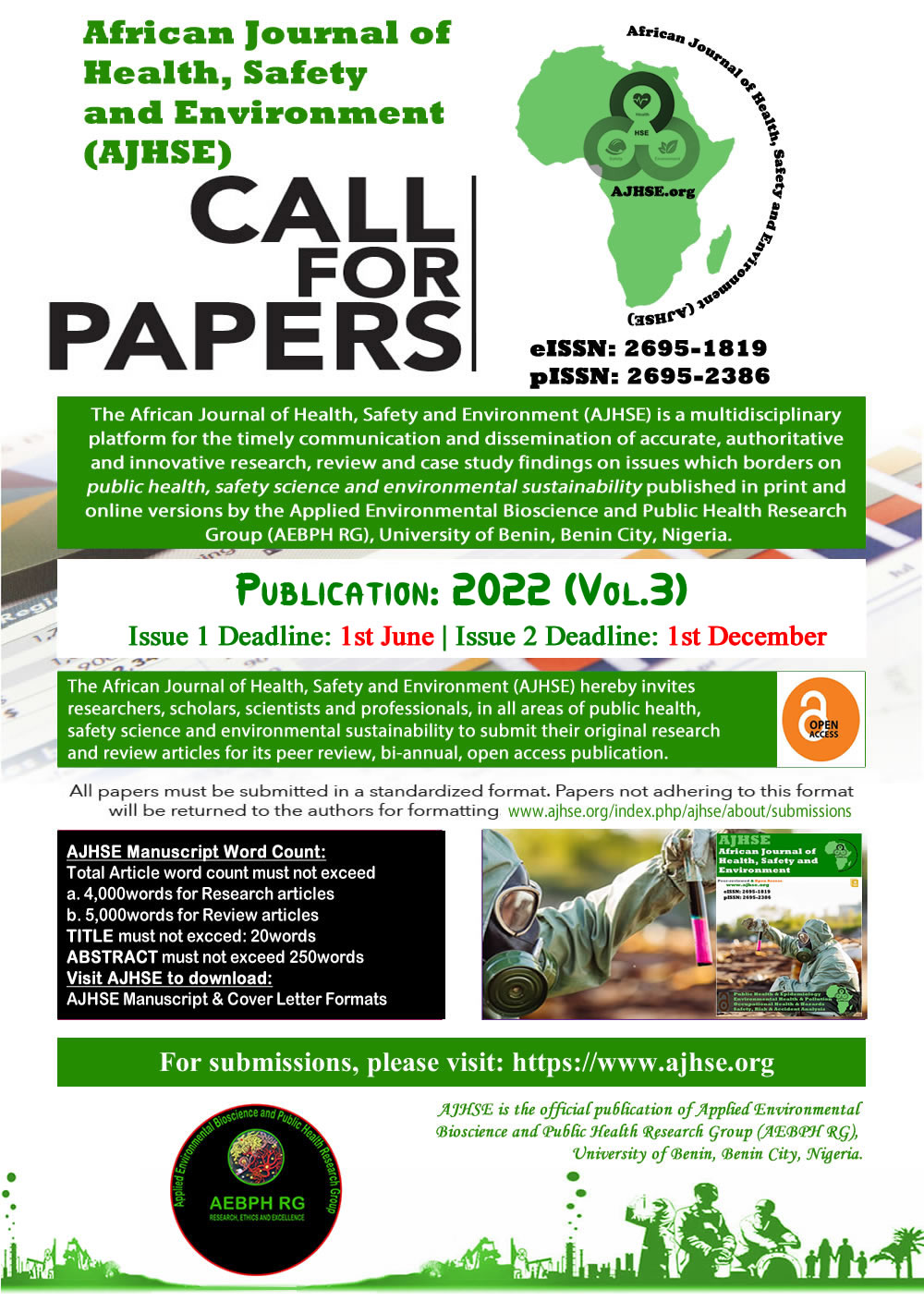EFFECTS OF SOIL SOLARIZATION ON FUNGAL AND BACTERIAL POPULATIONS ASSOCIATED WITH AMARANTHIS VIRIDIS L. (AFRICAN SPINACH) IN LAGOS, NIGERIA
(mysqli): SELECT a.*, ug.show_title, s.locale FROM authors a JOIN user_groups ug ON (a.user_group_id=ug.user_group_id) JOIN submissions s ON (s.submission_id = a.submission_id) WHERE a.submission_id = 168 ORDER BY seq
(mysqli): SELECT * FROM author_settings WHERE author_id = '302'
(mysqli): SELECT * FROM author_settings WHERE author_id = '303'
(mysqli): SELECT * FROM author_settings WHERE author_id = '304'
(mysqli): SELECT * FROM author_settings WHERE author_id = '305'
(mysqli): SELECT * FROM author_settings WHERE author_id = '306'
(mysqli): SELECT * FROM author_settings WHERE author_id = '307'
(mysqli): SELECT * FROM author_settings WHERE author_id = '308'
Abstract
Soil solarization is increasingly used to control soil-borne pathogens because it is environment-friendly. However, performance varied geographically, necessitating experimental trials before its introduction. This study assessed the effects of solarization on soil-borne bacteria and fungi, growth, and proximate composition of Amaranthus viridis (African spinach) in Lagos, Nigeria. Two raised beds were solarized for six weeks with a transparent and black polyethylene sheet, and a non-solarized (control) bed was equally made. The vegetable seeds were planted and their growths were recorded for four weeks. Soil samples at 15-20cm deep and leaves were obtained for microbiological and proximate analysis, respectively. The mean temperature of transparent xxpolyethylene’s soil was 45.33 oC, black polyethylene (35 oC), and non-solarized (33.50 oC). The mean height and width of transparent polyethylene’s A. viridis were 24 and 3cm, black polyethylene (19 and 2.2 cm), and non-solarized (17 and 1.6cm). The transparent polyethylene’s soil had 3100 and 250 cfu/g bacterial and fungal colonies, black polyethylene (3200 and 1900 cfu/g), and non-solarized (37000 and 1900 cfu/g), respectively. The proximate contents of the transparent polyethylene’s A. viridis were (70 moisture, 10 ash, 4.24 protein, 1.45 fat and 9.94 % fibre), black polyethylene (73.35 moisture, 8.36 ash, 3.1% protein, 1.23 fat, and 6.77 % fibre), and non-solarized (76.09 moisture, 5.91 protein, 3.15 ash, 1.31 fat and 6.75 % fibre). Overall, statistical differences (p ≤ 0.05) existed between the solarized and non-solarized and between transparent and black polyethylene (transparent>black>non-solarized). Thus, solarization could be an effective strategy for controlling soil-borne bacteria and fungi of A. viridis in the area studied.
(mysqli): SELECT COUNT(*) FROM plugin_settings WHERE plugin_name = 'usagestatsplugin' AND context_id = 1 AND setting_name = 'displayStatistics'
(mysqli): SELECT setting_name, setting_value, setting_type FROM plugin_settings WHERE plugin_name = 'usagestatsplugin' AND context_id = 1
(mysqli): SELECT a.*, ug.show_title, s.locale FROM authors a JOIN user_groups ug ON (a.user_group_id=ug.user_group_id) JOIN submissions s ON (s.submission_id = a.submission_id) WHERE a.submission_id = 168 ORDER BY seq
(mysqli): SELECT * FROM author_settings WHERE author_id = '302'
(mysqli): SELECT * FROM author_settings WHERE author_id = '303'
(mysqli): SELECT * FROM author_settings WHERE author_id = '304'
(mysqli): SELECT * FROM author_settings WHERE author_id = '305'
(mysqli): SELECT * FROM author_settings WHERE author_id = '306'
(mysqli): SELECT * FROM author_settings WHERE author_id = '307'
(mysqli): SELECT * FROM author_settings WHERE author_id = '308'
Copyright (c) 2021 Yahaya

This work is licensed under a Creative Commons Attribution 4.0 International License.












